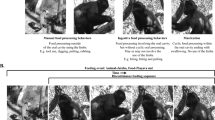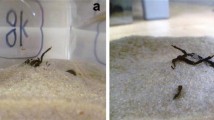Summary
1. The food and feeding behavior of Openbill Storks,Anastomus lamelligerus andAnastomus oscitans, were studied in Africa, India, Ceylon, and Thailand, during parts of 1963–68.
2. My observations and a survey of the literature indicate that shelled molluscs (principally snails of the genusPila) make up a major portion of the prey taken by both species.
3. The usual method of extracting the molluscan body from the shell is described. Most commonly the tip of the lower mandible is inserted into the shell and the body dislodged, without great damage being done to the shell. The popular notion that the open bill functions in the fashion of a “nutcracker” is not supported by my observations.
4. It is suggested that the major adaptive advantage of the open bill is that it gives the birdconvergent mandible tips, which assist in the grasping and carrying of molluscs as well as their extraction.
5. The question of whether the gap in the bill itself has any direct function and its mode and time of development could best be answered through observations and experiments on captive birds.
Zusammenfassung
Die Nahrung und Nahrungsaufnahme der KlaffschnäbelAnastomus lamelligerus undA. oscitans wurde von 1963 bis 1968 auf mehreren Reisen nach Afrika, Indien, Ceylon und Thailand untersucht.
Nach den vorliegenden Beobachtungen, die mit anderen Literaturangaben übereinstimmen, besteht die Nahrung beider Arten hauptsächlich aus beschalten Mollusken, vornehmlich Schnecken der GattungPila.
Zur Extraktion des Molluskenkörpers aus der Schale führt der Klaffschnabel die Spitze seines Unterschnabels in das Schneckengehäuse ein und holt damit den Weichkörper heraus, ohne die Schale zu zerbrechen. Mitunter brechen kleine Splitter von der Schalenlippe ab. Die verbreitete Auffassung, nach der der klaffende Schnabel wie ein Nußknacker die Molluskenschale öffnen würde, wird durch die vorliegenden Beobachtungen nicht bestätigt.
Die adaptive Bedeutung des offenen Schnabels ist sehr wahrscheinlich die Ausbildung der konvergenten Mandibelspitzen, mit denen die Klaffschnäbel die Mollusken vornehmlich ergreifen, tragen und aus der Schale extrahieren.
Die Untersuchung, ob der Schnabelspalt als solcher eine direkte Funktion bei der Nahrungsaufnahme aufweist, und die Frage nach seiner ontogenetischen Entwicklung sind weiteren Studien an gekäfigten Vögeln vorbehalten.
Similar content being viewed by others
Literature Cited
Ali, S., andS. D. Ripley (1968): Handbook of the Birds of India and Pakistan. Vol. 1. — London: Oxford Univ. Press. 380 p.
Bannerman, D. A. (1953): The Birds of West and Equatorial Africa. Vol. 1. — Edinburgh: Oliver and Boyd. 795 p.
Beddard, F. E. (1901): Some notes upon the anatomy and systematic position of the ciconiine genusAnastomus. — Proc. Zool. Soc. London 1901 (pt. 1), p. 365–371.
Benson, C. W., andC. R. S. Pitman (1958): Further breeding records from Northern Rhodesia. — Bull. Brit. Orn. Club 78, p. 164–166.
Chapin, J. P. (1932): The birds of the Belgian Congo. Part 1. — Bull. Amer. Mus. Nat. Hist. 65, p. 1–756.
Hamling, H. H. (1953): Observations on the behaviour of birds in Southern Rhodesia. — Ostrich 24, p. 9–16.
Henry, G. M. (1955): A Guide to the Birds of Ceylon. — London: Oxford Univ. Press.
Heuglin, M. T. von (1873): Ornithologie Nordost-Afrika's. — Cassel: Fischer.
Huxley, J. S. (1960): The Openbill's open bill: a teleonomic enquiry. — Zool. Jahrb. (Abt. Syst.) 88, p. 9–30.
—— (1962): The Openbill Stork,Anastomus oscitans. — Ibis 104, p. 112.
Jackson, F. J. (1938): The Birds of Kenya Colony and the Uganda Protectorate. Vol. 1. — London: Gurney and Jackson. 542 p.
Jerdon, T. C. (1864): The Birds of India. — Calcutta: Wyman.
Kahl, M. P. (1966): A contribution to the ecology and reproductive biology of the Marabou Stork (Leptoptilos crumeniferus) in East Africa. — J. Zool. 148, p. 289–311.
Krishnan, M. (1960): The Vedanthangal Sanctuary for water-birds. — Madras: State Forest Dept. 25 p.
Legge, W. V. (1880): A History of the Birds of Ceylon. — London. 1237 p.
Norton-Griffiths, M. (1967): Some ecological aspects of the feeding behaviour of the OystercatcherHaematopus ostralegus on the edible musselMytilus edulis. — Ibis 109, p. 412–424.
Rand, A. L. (1936): The distribution and habits of Madagascar birds. — Bull. Amer. Mus. Nat. Hist. 72, p. 143–499.
Reichenow, A. (1900): Die Vögel Afrikas. Band 1. — Neudamm: Neumann.
Root, A. (1963): Notes on the feeding habits of the Openbill StorkAnastomus lamelligerus. — Ibis 105, p. 399–400.
Ruwet, J.-C. (1963): Notes écologiques et éthologiques sur les oiseaux des plaines de la Lufira supérieure (Katanga). 1. Podicipedes, Steganapodes, Gressores, Anseres. — Rev. Zool. Bot. afr. 68, p. 1–60.
Snyder, N. F. R., andH. A. Snyder (1969): A comparative study of mollusc predation by Limpkins, Everglade Kites, and Boat-tailed Grackles. — Living Bird 8, p. 177–223.
Wait, W. E. (1925): Manual of the Birds of Ceylon. — Colombo.
White, C. M. N. (1943): Field notes on some birds of Mwinilunga, Northern Rhodesia. — Ibis 85, p. 127–131.
Author information
Authors and Affiliations
Additional information
This paper is respectfully dedicated to Prof. Dr.Ernst Schüz on the occasion of his 69th birthday (24 October 1970), in recognition of his nearly 40 years' research on storks.
Rights and permissions
About this article
Cite this article
Kahl, M.P. Food and feeding behavior of Openbill Storks. J Ornithol 112, 21–35 (1971). https://doi.org/10.1007/BF01644077
Published:
Issue Date:
DOI: https://doi.org/10.1007/BF01644077




